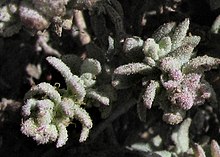
Amaranthaceae is a family of flowering plants commonly known as the amaranth family, in reference to its type genus Amaranthus. It includes the former goosefoot family Chenopodiaceae and contains about 165 genera and 2,040 species, making it the most species-rich lineage within its parent order, Caryophyllales.

The Chenopodioideae are a subfamily of the flowering plant family Amaranthaceae in the APG III system, which is largely based on molecular phylogeny, but were included - together with other subfamilies - in family Chenopodiaceae in the Cronquist system. Food species comprise Spinach, Good King Henry, several Chenopodium species, Orache, and Epazote. The name is Greek for goosefoot, the common name of a genus of plants having small greenish flowers.

Atriplex is a plant genus of 250–300 species, known by the common names of saltbush and orache. It belongs to the subfamily Chenopodioideae of the family Amaranthaceae s.l.. The genus is quite variable and widely distributed. It includes many desert and seashore plants and halophytes, as well as plants of moist environments. The generic name originated in Latin and was applied by Pliny the Elder to the edible oraches. The name saltbush derives from the fact that the plants retain salt in their leaves; they are able to grow in areas affected by soil salination.

Halimione portulacoides or sea purslane (2n=36) is a small greyish-green shrub widely distributed in temperate Eurasia and parts of Africa.
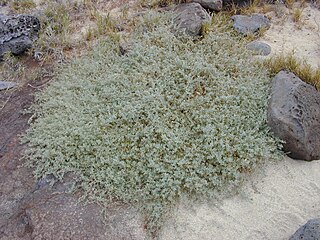
Atriplex semibaccata, commonly known as Australian saltbush, berry saltbush, or creeping saltbush, is a species of flowering plant in the family Amaranthaceae and is endemic to Australia. It is a perennial herb native to Western Australia, South Australia, Queensland and New South Wales, but has been introduced into other states and to overseas countries. It flowers and fruits in spring, and propagates from seed when the fruit splits open. This species of saltbush is adapted to inconsistent rainfall, temperature and humidity extremes and to poor soil. It is used for rehabilitation, medicine, as a cover crop and for fodder. Its introduction to other countries has had an environmental and economic impact on them.

Tityridae is family of suboscine passerine birds found in forest and woodland in the Neotropics. The 45 species in this family were formerly spread over the families Tyrannidae, Pipridae and Cotingidae. As yet, no widely accepted common name exists for the family, although tityras and allies and tityras, mourners and allies have been used. They are small to medium-sized birds. Under current classification, the family ranges in size from the buff-throated purpletuft, at 9.5 cm (3.7 in) and 10 grams, to the masked tityra, at up to 24 cm (9.5 in) and 88 grams. Most have relatively short tails and large heads.

Grayia is a genus of plants in the subfamily Chenopodioideae of the family Amaranthaceae. Common names are siltbush and hopsage. The four shrubby species occur in arid and semiarid regions of western North America:
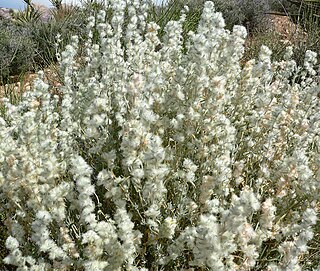
Krascheninnikovia is a genus of flowering plants in the subfamily Chenopodioideae of the family Amaranthaceae known as winterfat, so-called because it is a nutritious livestock forage. They are known from Eurasia and western North America. These are hairy perennials or small shrubs which may be monoecious or dioecious. They bear spike inflorescences of woolly flowers.
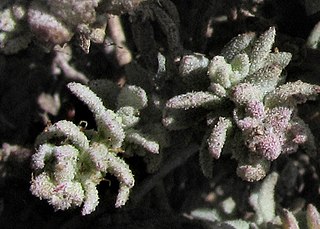
Extriplex californica is a plant species known by the common name California saltbush or California orache. Formerly, it was included in genus Atriplex. It is native to coastal California and Baja California, where it grows in areas with saline soils, such as beaches and salt marshes.
Extriplex joaquinana is a species known by the common name San Joaquin saltbush. It was formerly included in genus Atriplex.

The Betoideae are a small subfamily of the flowering plant amaranth family, Amaranthaceae sensu lato. Commonly known members include beet, sugar beet, chard, and mangelwurzel, which all are cultivars of Beta vulgaris.

Chenopodiastrum is a genus of herbaceous flowering plants in the family Amaranthaceae. The genus was formally described in 2012. The 5 species occur in Eurasia, North Africa, and North America.
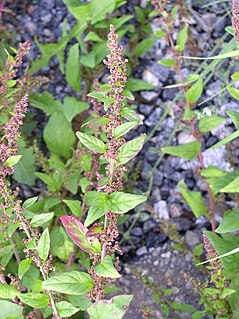
Lipandra polysperma, common name manyseed goosefoot, is the only species of the monotypic plant genus Lipandra from the subfamily Chenopodioideae of the family Amaranthaceae.

Halimione is a plant genus from the subfamily Chenopodioideae of the family Amaranthaceae. It is a sister genus of Atriplex and has sometimes been included in this genus.

Extriplex is a plant genus in the subfamily Chenopodioideae of the family Amaranthaceae. It has been described in 2010 and comprises two species, that were formerly included in genus Atriplex. They are restricted to the California Floristic Province.

Stutzia is a plant genus in the subfamily Chenopodioideae of the family Amaranthaceae. It was described in 2010, replacing the illegitimate name Endolepis. It comprises two species, that have also been included in the genus Atriplex.
Proatriplex is a monotypic plant genus in the subfamily Chenopodioideae of the family Amaranthaceae, with the only species Proatriplex pleiantha. It is known by the common names Four-corners orach and Mancos shadscale. It occurs in the Navajo Basin of Arizona, Colorado, New Mexico, and Utah.

Atriplex holocarpa is a low-growing species of Atriplex (saltbush) found throughout arid regions of Australia. A. holocarpa is commonly known as pop saltbush, because its carpals pop when stepped upon.
Ge Lin Chu is a Chinese botanist.
Exomis is a genus of flowering plants belonging to the family Amaranthaceae. It just contains one species, Exomis microphylla(Thunb.) Aellen It is also in the Chenopodioideae subfamily.
